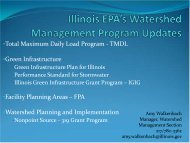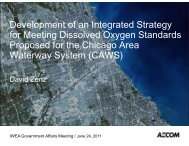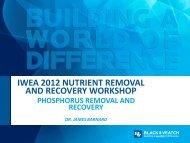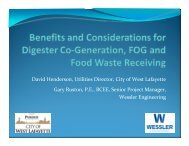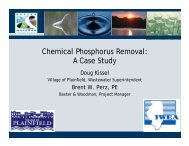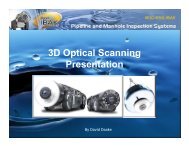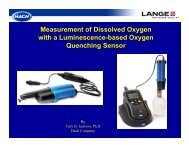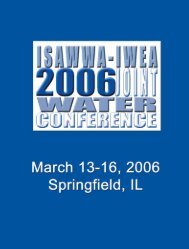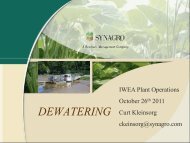City of Plano Case Study - Illinois Water Environment Association
City of Plano Case Study - Illinois Water Environment Association
City of Plano Case Study - Illinois Water Environment Association
Create successful ePaper yourself
Turn your PDF publications into a flip-book with our unique Google optimized e-Paper software.
“Operation <strong>of</strong> the Biological Nutrient RemovalProcess at the <strong>City</strong> <strong>of</strong> <strong>Plano</strong>, <strong>Illinois</strong> <strong>Water</strong>Reclamation Facility"Presented by:Darrin B. Boyer - <strong>City</strong> <strong>of</strong> <strong>Plano</strong>- <strong>Illinois</strong>Mark J. Halm, P.E. - Walter E. Deuchler Associates, Inc.
Presentation Outline‣ Today’s presentation will focus on:• Background• Liquid Train Design Elements• Preliminary Treatment• Secondary Treatment• Focus on Nutrient Removal• Solids Train Design Elements• Startup• Operational Challenges• Process Performance
Background‣ Walter E. Deuchler Associates, Inc. (WEDA) began planningwith the <strong>City</strong> <strong>of</strong> <strong>Plano</strong> in 2002‣ WEDA embarked on the design <strong>of</strong> the <strong>Water</strong> ReclamationFacility Improvements Project in 2004‣ The $13.6 million Improvements Project was completed inNovember 2006.‣ The design average flow capacity <strong>of</strong> the plant was increasedfrom 0.95 MGD to 2.44 MGD.
Liquid Train Design Elements‣ Preliminary Treatment Building houses:• Raw sewage enters the building via gravity• Two 6 mm bar screens, washers and compactors• Two aerated grit tanks• Three recessed impeller grit pumps• Two grit classifiers• Conveyor for compacted/washed screening and classified grit• Equalization Tanks Downstream <strong>of</strong> Grit/ Used as Fermenters
Liquid Train Design Elements‣ Secondary Treatment Control Building houses:• The mixed liquor flow distribution valves to the final clarifiers,• The non-potable water reuse pumps,• The plant drainage/scum pumps, and• The internal return pumps which pump mixed liquor at a rate up to300% <strong>of</strong> the influent flow to the anoxic selectors for denitrification• Series Selector Tanks for Biological Nutrient Removal
Liquid Train Design Elements‣ Secondary Treatment, continued:• Series Aeration Tanks• Two 75 foot diameter Final Clarifiers• New Blower Building and 1.2 MW Generator• Plant will be installing 75 HP turbo blower/ funded in part by DCEOGrant
Solids Train Design Elements‣ WAS Holding‣ Rotary Drum Thickening‣ Aerobic Digestion‣ Centrifuge Dewatering‣ Sludge Storage and Land Application
Design Elements
Focus on – Nutrient Removal‣ Goal: TP removal‣ Screening <strong>of</strong> Biological Processes• AO – TP• A2O – TP and TN• UCT –TP and TN• VIP- TP and TN• Bardenpho – TP and TN‣ Chemical Polishing
Focus on – Nutrient Removal‣ Important Elements• Operational Flexibility/ Anaerobic, Anoxic, Aerobic• Instrumentation and Control• Chemical Polishing• Separate Treatment <strong>of</strong> Recycle Flows• Thickener Filtrate• Centrifuge Centrate‣ Concerns• VFA Production/ TP to BOD5 Ratio• Nitrate and Dissolved Oxygen Inhibition <strong>of</strong> Bio-P Process• Secondary Release <strong>of</strong> Phosphorus due to extended HRT
Focus On –Nutrient Removal‣ Design Methodology• Laboratory Testing• Mass Balance Calculations• Steady State Process Modeling – BiowinSuspended DissolvedOrthophosphorusPolyphosphorusOrganicphosphorusOrthophosphorusTotal soluble phosphorusTotalphosphorus
Focus On –Nutrient Removal‣ BOD/TP> 20, 92.5%‣ BOD/TP> 25, 67.5%‣ Better Measure rbCOD/TP‣ Preliminary Conclusion- BioP a Viable Process100%95%Probability <strong>of</strong> Exceedance90%85%80%75%70%65%60%55%50%15161718192021222324252627282930BOD/TP
Focus On –Nutrient Removal
Focus On –Nutrient RemovalAnaerobicHRTAnoxicHRTAerobicHRTTotal HRTA2O 1.50 1.00 8.00 10.50AsConstructedCurrentOperation1.60 1.42 8.60 11.623.46 2.30 13.56 19.322.44 MGD0.75 MGD
Focus On –Nutrient Removal
Focus On –Nutrient Removal
Process Performance: Influent012345670.00.51.01.52.02.53.03.51-Jan-101-Feb-101-Mar-101-Apr-101-May-101-Jun-101-Jul-101-Aug-101-Sep-101-Oct-101-Nov-101-Dec-101-Jan-111-Feb-111-Mar-111-Apr-111-May-111-Jun-111-Jul-111-Aug-111-Sep-111-Oct-111-Nov-111-Dec-111-Jan-121-Feb-121-Mar-121-Apr-121-May-121-Jun-121-Jul-121-Aug-12Rainfall, InchesFLOW (MGD)
Process Performance: Influent400350300250BOD5 (mg/l)200150100500Jan-10Feb-10Mar-10Apr-10May-10Jun-10Jul-10Aug-10Sep-10Oct-10Nov-10Dec-10Jan-11Feb-11Mar-11Apr-11May-11Jun-11Jul-11Aug-11Sep-11Oct-11Nov-11Dec-11Jan-12Feb-12Mar-12Apr-12May-12Jun-12Jul-12Aug-12
Process Performance: Influent400350300250TSS (mg/l)200150100500Jan-10Feb-10Mar-10Apr-10May-10Jun-10Jul-10Aug-10Sep-10Oct-10Nov-10Dec-10Jan-11Feb-11Mar-11Apr-11May-11Jun-11Jul-11Aug-11Sep-11Oct-11Nov-11Dec-11Jan-12Feb-12Mar-12Apr-12May-12Jun-12Jul-12Aug-12
Process Performance: Influent8765TP (mg/l)43210Sep-11Sep-11Sep-11Oct-11Oct-11Nov-11Nov-11Dec-11Dec-11Jan-12Jan-12Feb-12Feb-12Mar-12Mar-12Mar-12Apr-12Apr-12May-12May-12Jun-12Jun-12Jul-12Jul-12Aug-12Aug-12Aug-12
Process Performance: Effluent20181614BOD (mg/l)121086420Jan-10Feb-10Mar-10Apr-10May-10Jun-10Jul-10Aug-10Sep-10Oct-10Nov-10Dec-10Jan-11Feb-11Mar-11Apr-11May-11Jun-11Jul-11Aug-11Sep-11Oct-11Nov-11Dec-11Jan-12Feb-12Mar-12Apr-12May-12Jun-12Jul-12Aug-12
Process Performance: Effluent024681012141618202224Jan-10Feb-10Mar-10Apr-10May-10Jun-10Jul-10Aug-10Sep-10Oct-10Nov-10Dec-10Jan-11Feb-11Mar-11Apr-11May-11Jun-11Jul-11Aug-11Sep-11Oct-11Nov-11Dec-11Jan-12Feb-12Mar-12Apr-12May-12Jun-12Jul-12Aug-12TSS (mg/l)
Process Performance: Effluent10.90.80.7NH3-N (mg/l)0.60.50.40.30.20.10Jan-10Feb-10Mar-10Apr-10May-10Jun-10Jul-10Aug-10Sep-10Oct-10Nov-10Dec-10Jan-11Feb-11Mar-11Apr-11May-11Jun-11Jul-11Aug-11Sep-11Oct-11Nov-11Dec-11Jan-12Feb-12Mar-12Apr-12May-12Jun-12Jul-12Aug-12
Process Performance: Effluent4.54.03.53.0TP (mg/l)2.52.01.51.00.50.0Jan-10Feb-10Mar-10Apr-10May-10Jun-10Jul-10Aug-10Sep-10Oct-10Nov-10Dec-10Jan-11Feb-11Mar-11Apr-11May-11Jun-11Jul-11Aug-11Sep-11Oct-11Nov-11Dec-11Jan-12Feb-12Mar-12Apr-12May-12Jun-12Jul-12Aug-12
Process Performance:Daily EffluentProbability <strong>of</strong> Exceedance100%10%8% Chance <strong>of</strong>Exceeding TP <strong>of</strong> 1mg/l on a DailyBasis1%-0.501.001.502.002.50Daily Effluent TP, mg/l
Process Performance:Monthly Average Effluent100%Probability <strong>of</strong> Exceedance10%3.5% Chance <strong>of</strong>Exceeding TP <strong>of</strong> 1mg/l on a MonthlyBasis1%-0.100.200.300.400.500.600.700.800.901.001.101.201.301.401.501.60Monthy Average TP, mg/l
Process Performance:Average TP Percent Removal100.0095.0090.0085.0080.0075.0070.0065.0060.0055.0050.00Oct-11Nov-11Dec-11Jan-12Feb-12Mar-12Apr-12May-12Jun-12Jul-12Aug-12
Process Optimization‣ Sewers are fermenters/ after a rainfall the Bio-P processneeds time to recover‣ Using equalization tanks as fermenters for VFA production‣ Always dose the centrate with alum/ be mindful <strong>of</strong> recycleflows‣ Control aeration DO and carryover DO in MLSS to anaerobiczone‣ Measure ORP in Selector Tanks‣ Have sufficient flexibility to limit HRT in anaerobic zone toprevent potential secondary release <strong>of</strong> P‣ Consider separate denitrification <strong>of</strong> RAS stream(Johannesburg Process) or return RAS to anoxic zone with 1 Qrecycle. Build this flexibility into the system.
Recommendations and Conclusions‣ Recommendations• Collect and analyze influent data• Check typical ratios rbCOD/TP, etc.• Consider process modeling• Treat recycle flow separately• Account for Nitrate and DO as inhibitors <strong>of</strong> Bio-P‣ Conclusions• Bio-P is a viable and cost effective process if properlydesigned with flexibility in operation
Thank You




